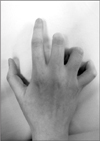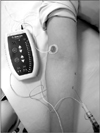Abstract
Focal dystonia of musicians is one of the most disabling problems for professional musicians. It has focal task-specificity, presenting with involuntary flexion or extension of individual fingers when musicians play their instruments. It occurs mostly in pianists, and controversies still exist about the pathophysiology, whether it is caused by motor function disability or by a psychological condition. Although sensorimotor rehabilitation, change in instrument, skill or teacher, and immobilization with brace have been tried as treatment, there is still no definitive treatment. Because botox therapy has been effective in certain cases without irreversible side effects, this could be applied even in professional players. We report a case of focal dystonia of the hand in a professional pianist treated using electromyogram-guided botox injection and a review of the relevant medical literature.
Figures and Tables
References
1. Schmidt A, Jabusch HC, Altenmüller E, et al. Etiology of musician's dystonia: familial or environmental? Neurology. 2009. 72:1248–1254.

2. Schuele S, Lederman RJ. Long-term outcome of focal dystonia in string instrumentalists. Mov Disord. 2004. 19:43–48.

3. Jabusch HC, Vauth H, Altenmüller E. Quantification of focal dystonia in pianists using scale analysis. Mov Disord. 2004. 19:171–180.

4. Truong D, Dressler D, Hallett M. Manual of Botulinum toxin therapy. 2009. New York: Cambridge University Press;61–75.
5. Poore GV. Clinical lecture on certain conditions of the hand and arm which interfere with the performance of professional acts, especially piano-playing. Br Med J. 1887. 1:441–444.

6. Nourissat G, Chamagne P, Dumontier C. Reasons why musicians consult hand surgeons. Rev Chir Orthop Reparatrice Appar Mot. 2003. 89:524–531.
7. Byl NN, Merzenich MM, Jenkins WM. A primate genesis model of focal dystonia and repetitive strain injury: I. Learning-induced dedifferentiation of the representation of the hand in the primary somatosensory cortex in adult monkeys. Neurology. 1996. 47:508–520.
8. Rosenkranz K, Butler K, Williamon A, Rothwell JC. Regaining motor control in musician's dystonia by restoring sensorimotor organization. J Neurosci. 2009. 29:14627–14636.





 PDF
PDF ePub
ePub Citation
Citation Print
Print




 XML Download
XML Download